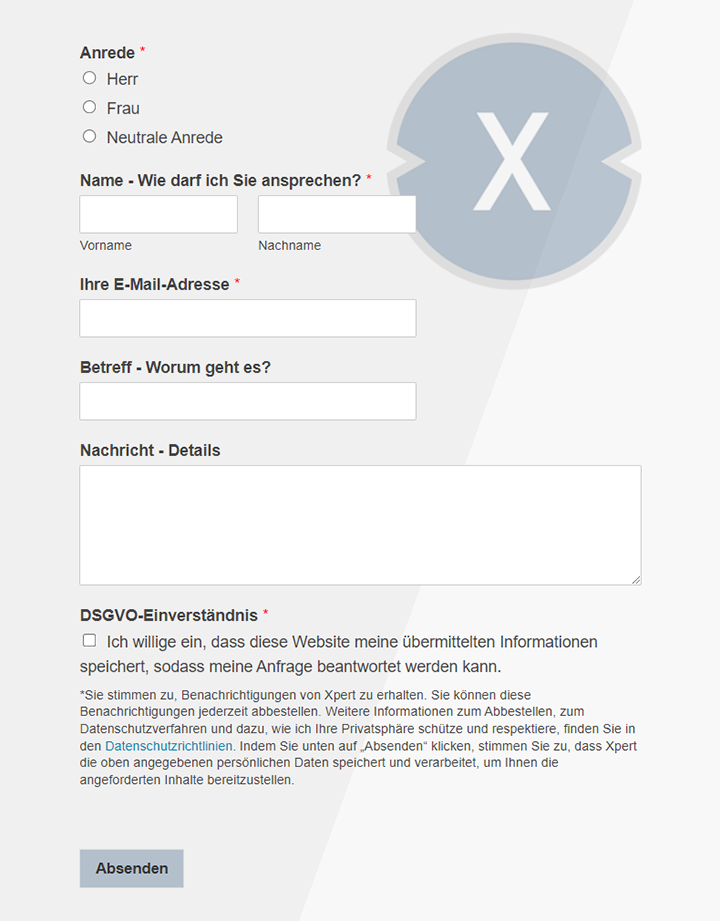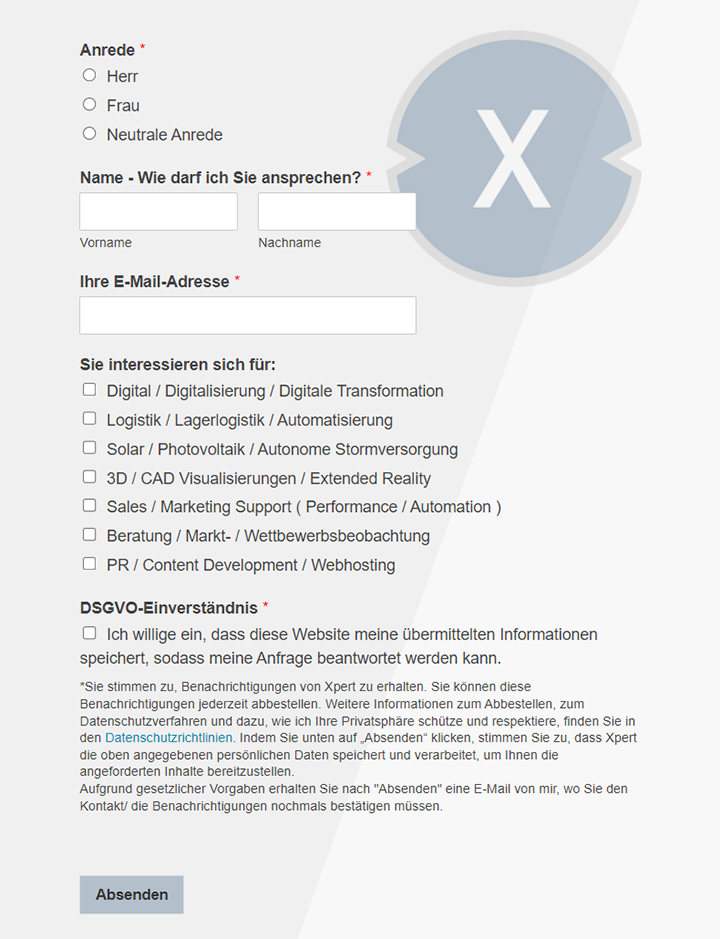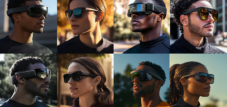Smart Glasses: AI glasses conquer the world? Do you revolutionize our everyday life with AI and AR or do you stay niche?
Xpert pre-release
Language selection 📢
Published on: April 14, 2025 / update from: April 14, 2025 - Author: Konrad Wolfenstein

Smart Glasses: AI glasses conquer the world? Do you revolutionize our everyday life with AI and AR or do you stay niche? - Image: Xpert.digital
The market for smart glasses: a renaissance of technology, competition and the future prospects
More than just a hype - the rebirth of the smart glasses
The global market for smart glasses is located in the middle of a remarkable transformation. What was once considered a futuristic vision with limited success is now experiencing a rebirth, driven by groundbreaking advances in artificial intelligence (AI) and the introduction of products that are both technologically progressive and stylistically appealing. The initial enthusiasm, which was triggered by early products such as Google Glass, has a phase of disillusionment, since the devices proved to be impractical, expensive or socially unacceptable. But these times are over.
Current estimates indicate impressive growth of the market, with annual growth rates (CAGR) from 27 % to over 60 % in the coming years. This dynamic attracts a large number of new competitors, which leads to an intensive competition that has the potential to redefine the landscape of portable technology. The current market numbers speak for themselves: In 2023, global deliveries rose by a remarkable 156 % and are expected to increase by a further 210 % in 2024. This means that the two million units delivered for the first time - a milestone that underlines the enormous potential of this technology.
This upswing is not just a temporary trend, but a fundamental realignment of the market. Previous generations of Smart Glasses often failed due to the lack of convincing applications and concerns about design and data protection. The new wave of devices, led by AI-based functions such as voice assistant, contextual information and real-time translation, integrated into fashionable designs, depends on these vulnerabilities directly. This indicates that the current growth phase could be more sustainable because it builds on the teachings from past mistakes and overcomes fundamental adoption barriers.
Suitable for:
Technology in detail: concepts, components and trends
The term “smart glasses” includes a growing variety of devices with different skills and objectives. In order to understand the complexity of this market, it is important to differentiate the different categories and the underlying technologies.
Classic Smart Glasses
These devices focus on discreetly displaying information in the user's field of vision and offering fundamental connectivity and media functions. They often resemble traditional glasses and act primarily as companions for smartphones. The main features include an information display, Bluetooth/WLAN connectivity, basic sensors (accelerometer), hands-free language control and sometimes cameras for simple recordings. These glasses target everyday users who are looking for comfortable access to information, free -handed communication and basic assistance functions.
Augmented Reality (AR) glasses
AR glasses go beyond the pure information indicator by overlapping the real world directly and interactively with digital content. They merge virtual elements with the physical environment and destinations on spatial understanding and interaction. The main features include AR overlays (overlays), interactive virtual elements, 3D presentation, spatial understanding (using cameras/sensors such as DOF-tracking) and context-related information. These devices are aimed at specialists in industry, medicine, education, gaming and entertainment as well as developers.
Extended reality (XR) glasses
XR is an umbrella term that includes AR, Virtual Reality (VR) and Mixed Reality (MR). XR devices aim to enable experiences across this entire spectrum by possibly switching or mixing them between different modes. MR is often realized by Passhrough video, in which the real environment is captured by cameras and combined with virtual elements on the display. XR glasses offer an ability for AR-overlays and/or completely immersive VR, often using PASSHROUGH cameras for MR, advanced spatial tracking (e.g. 6dof) and hand tracking. The target audience is wide and ranges from players and entertainment consumers to experts who need diverse tools for simulation, collaboration and visualization.
The category “XR” not only represents a device type, but rather a technological direction of development towards the integration of different levels of reality. Future devices may no longer be clearly classified in “AR” or “VR”, but will offer a fluid spectrum of experiences, enables advanced passportthrough technology and highly developed software platforms. This convergence complicates a simple categorization, but indicates a future with more versatile hardware, which dissolves from rigid AR/VR definitions and becomes a uniform, flexible platform for digital interaction.
Suitable for:
Key technologies and innovations
The progress in the smart glasses market is significantly promoted by innovations in key technologies:
Display technologies
The display technology is crucial for the user experience. Progress focuses on brightness, resolution, field of vision (Field of View, FOV), energy efficiency and form factor (transparency, weight). The key technologies include Micro-Oled, LCOS (Liquid Crystal on Silicon), Microled and Waveeguides (light guide). The choice of display technology significantly determines the primary application and the form factor of the device.
Artificial Intelligence (AI)
Ki transforms Smart Glasses from passive display devices to interactive, intelligent assistants and is the main driver behind the latest market swing. AI functions include natural language processing (NLP), computer vision, proactive and context-related assistance as well as multimodale AI. The AI integration takes place directly on the device and via the connection to smartphones or the cloud. AI is not just another feature, but also develops into a core promise of value in the segment of the Consumer Smart Glasses.
Processors and chipsets
Powerful, yet energy-efficient processors are required to cope with AI tasks, sensorus and graphics rendering, especially for AR/XR. Qualcomm is a key player with his specially developed Snapdragon XR platforms. The balance between power, power consumption and heat discharge in a small form factor is a major challenge.
Battery time and energy efficiency
The battery life remains one of the greatest challenges. Improvements result from more efficient components, better power management in software and advances in battery technology. Reaching a “all -day” battery life is a critical milestone so that smart glasses can grow beyond niche applications and become really integrated everyday companions.
Connectivity
Connectivity is essential for access to data, cloud AI and the interaction with other devices. Standard technologies are Bluetooth (for smartphone coupling, audio) and WLAN. The introduction of 5G is seen as a significant opportunity, since it offers high speeds and low latency times that are decisive for demanding AR/XR experiences and the outsourcing of computing power to the EDGE/cloud.
Software platforms and ecosystems
Special operating systems for XR are established. Google has announced Android XR and works with partners to create a wide platform for different device types. Meta uses its own platform for quest headsets and Ray-Ban glasses. Apple relies on visionos for the Vision Pro. The Smart Glasses Markt enters a phase of the platform competition, similar to the struggle of smartphone operating systems. The success of these platforms will depend heavily on attracting developers and enabling seamless experiences over the hardware of different manufacturers.
Market analysis: size, growth and forecasts
The evaluation of the global market size for Smart Glasses is complex, since the definitions and the scope of the analyzed segments vary greatly between various market research companies.
Estimates for the pure Smart Glasses market in 2024 ranges from USD 878.8 million to USD 5.98 billion. These discrepancies are likely to be attributed to different definitions which device types are trapped. A value of $ 2.47 billion is forecast for 2025, and for 2030 the forecasts are $ 4.13 billion or $ 8.26 billion.
The broader market for AR/VR Smart Glasses was estimated at $ 16.6 billion in 2023 and $ 45.6 billion in 2024. Forecasts for the future range from $ 41.6 billion by 2029 over $ 47.9 billion to $ 120.87 billion to 2033.
The forecasts for annual growth are consistently high, but also vary greatly. For smart glasses, the CAGR estimates are between 14.5 % and 29.4 %. Driven by the success of the Ray-Ban Meta, a CAGR of over 60 % is forecast by 2029. For the AR/VR Smart Glasses market, the CAGR forecasts are 11.44 % to 18.0 %.
The market is segmented according to various criteria:
Device type
Monocular vs. Binocular; Basic vs. Extended functions.
technology
Ar, VR, mr.
Connectivity
WLAN, Bluetooth, mobile radio.
Application
Consumers vs. company.
Regional analysis
North America
Currently dominates the market share due to the strong presence of key players, high technology acceptance and beneficial framework conditions.
Asia-Pacific
Expects the fastest growth due to the strong production base, large consumer markets, the presence of manufacturers and lower manufacturing costs.
Europe
Holds a significant market share. Growth is driven by technological progress, demand for energy -efficient products and potentially through regulatory framework.
The significant spread of estimates for market size and CAGR illustrates the lack of a standardized market definition and a significant uncertainty. The extremely high CAGR forecasts of some sources are probably strongly influenced by the currently low basis and the expected influence of AI glasses. This indicates a potentially volatile growth rather than a steady, predictable expansion.
🎯🎯🎯 Benefit from Xpert.Digital's extensive, fivefold expertise in a comprehensive service package | R&D, XR, PR & SEM

AI & XR 3D Rendering Machine: Fivefold expertise from Xpert.Digital in a comprehensive service package, R&D XR, PR & SEM - Image: Xpert.Digital
Xpert.Digital has in-depth knowledge of various industries. This allows us to develop tailor-made strategies that are tailored precisely to the requirements and challenges of your specific market segment. By continually analyzing market trends and following industry developments, we can act with foresight and offer innovative solutions. Through the combination of experience and knowledge, we generate added value and give our customers a decisive competitive advantage.
More about it here:
AR, AI and competition: The future of the Smart Glasses market
Competition dynamics and strategies of the main actors
The market for Smart Glasses is becoming increasingly confusing and more competitive. Driven by the success of the Ray-Ban Meta and the perceived potential of the AI integration, numerous new players are pushing on the market. The competition takes place in various segments: consumer AI glasses, consumer-ar-glasses, enterprise-ar/MR solutions and high-end-xr headsets. The main players include established technologies, specialized AR/VR companies as well as numerous new market participants, especially from China.
Meta has developed a dominant position, especially after the introduction of the Ray-Ban Meta, and lasts over 60 % of the global market share at Smart Glasses. In the specific segment of AR glasses, Xreal takes a leading position with a market share of 47.3 % in the first half of 2024.
Meta
Leads the market for consumer AI glasses through the partnership with essilorluxottica. The focus is on fashionable design, camera/audio functions and integrated META AI assistant. Plant aggressive expansion from 2025. Dominant player in the VR area with the quest line.
Is currently focusing on providing the software platform (Android XR) and KI (Gemini) for partners instead of leading the market with their own hardware.
Samsung
Join the XR market again in partnership with Google and Qualcomm. Develop both an XR headset and AI-based smart glasses.
Apple
Is currently focusing on high-end spatial computing with the Apple Vision Pro. For the time being, no simpler, Mac-capable AR smart glass.
Xiaomi
Pursues a dual strategy that appeals to both the mass market and high-end users. Offers inexpensive audio glasses and more advanced AR glasses.
Asus
Focused on productivity and gaming applications with its portable display Airvision M1.
Solos
Aims at fitness enthusiasts and athletes with light audio glasses that offer AI coaching and tracking.
Vuzix
Mainly geared towards corporate, industrial, medical and defense markets. Offers robust AR-Smart glasses for applications such as remote maintenance, logistics and telemedicine. Also develops advanced wave conductor technology and display engine for ODM/OEM partners.
Rayneo (TCL)
Join the Consumer-AR/Smart Glasses market under the Rayneo brand. Offers both AR glasses with displays and simpler XR glasses.
XReal (Formerly Nreal)
Focus on consumer-ar-glasses, which are primarily positioned as portable displays for gaming, streaming and productivity. Aggressive global expansion and retail partnerships.
Lenovo
Speaks both gaming/consumer and enterprise segments. Legion Glasses as a portable display accessories and Thinkreaality AR glasses for companies.
Suitable for:
- The spearhead of the innovation: China's top manufacturer and developer (top ten) by smart glasses and augmented reality glasses
Areas of application and adoption patterns
Although consumer applications are increasingly attracting attention, the company sector is still the most ripe market for AR-based smart glasses, with demonstrable advantages in various industries.
Logistics and warehousing
“Vision picking” with AR overlays for picking instructions, storage space display and barcode scanning.
production
Remote maintenance, training, quality control, free -handed access to circuit diagrams and manuals.
Healthcare
Surgical support, remote diagnoses and consultations, medical training, telemedicine, free -handed access to patient files.
Service and maintenance
Remote support for experts, view of manuals and diagrams, documentation of works with photos/videos.
Various fields of application develop in the consumer market, which are often characterized by specific device types and functionalities.
Sports and fitness
Track workouts, display of performance data, navigation when cycling or running, AI-based coaching.
Gaming and entertainment
Provision of immersive gaming experiences, function as a large, virtual screens for console or PC games and video streaming.
Communication and social media
Free-handed calls, sending messages, recording and sharing photos and videos, live streaming.
Navigation and information access
Display of turn-by-turn navigation, points of interest, real-time translations, notifications, weather information.
The adaptation dynamics differ significantly between the consumer and the company market. Companies demand robustness, security, specific software integrations, long battery life and a demonstrable ROI. Consumers value style, comfort, user-friendliness, affordability, convincing apps/content and increasingly AI functions.
Challenges and adoption barriers
Despite the positive market dynamics and technological advances, there are still considerable challenges and barriers that hinder a broader adaptation of smart glasses:
Technological hurdles
Accounting time, display of limitation, performance/processing power, miniaturization.
Costs and affordability
High acquisition costs remain a barrier for mass acceptance.
Design, comfort and ergonomics
Devices must be user -friendly (light, comfortable and aesthetic) to be accepted by consumers: inside.
Data protection and security concerns
Integrated cameras or sensors provoke fears of secret surveillance and data collection. Devices could be rejected out of worry.
Social acceptance and ethical questions
The fear of being accepted unnoticed leads to social tensions and ethical discussions. This can cause resistance to the technology.
Content ecosystem and availability of applications
A limited range of high -quality, relevant and diverse content reduces the attractiveness of the devices and thus the willingness to use them.
Market fragmentation and standardization
The lack of compatibility between different platforms and devices increases the entry hurdle for users: inside and delays the market maturity of technologies.
Trust as a key to data protection overcoming
Data protection is not only technical, but also psychological and social nature. Users: Inside, it must be convinced that your privacy is actively protected - through transparent communication, user -centered designs and reliable measures for trust formation.
Suitable for:
- Smart Glasses and AR glasses: The future of the extended reality supported with artificial intelligence (AI)
Potential solutions
Design approaches for trust and acceptance
Devices should offer clear or visually clear signals (e.g. visible LED displays when recording or data acquisition) in order to make it clear and function of the technology.
Ergonomic and aesthetic designs can increase acceptance by combining user -friendliness and attractiveness.
Improved data protection communication
Users: Inside should be actively informed about the use, storage and protection of data. This could be done in the form of interactive tutorials or visual dashboards that promote transparency.
Social and ethical sensitization
Companies must respond to the ethical implications of their products and lead dialogues with society to reduce misunderstandings and resistance.
Expansion of the content ecosystem
Platform providers should work more closely with developers to create a diverse range of applications that offer both practical and entertaining uses.
Promote standardization
Cooperation between companies and regulatory organs is essential to define standard protocols that ensure interoperability between devices.
The adaptation of new technologies does not only depend on the technical performance, but also requires sensitive use of social, psychological and ethical aspects. The focus should focus on design and communication in order to promote broader trust and sustainable user acceptance.
Strategic outlook and recommendations
The market for Smart Glasses is redefined by the integration of AI, which leads to a resuscitation of interest and significant growth. At the same time, the market differentiates itself in consumer AI glasses and more demanding enterprise/immersive AR/XR devices.
Unexpected areas of application such as education and accessibility offer potential. Deeper integration with the Internet of Things (IoT) could create new synergies. In the long term, Smart Glasses could complement or partially replace other devices such as smartphones or smartwatches.
For manufacturers
Clear segment focus, AI as core competence, consumer focus (design, comfort, data protection), enterprise focus (ROI, integration, security), ODM/OEM strategy.
For software developers
Platform selection, use case, optimization, data protection.
For companies (potential users)
ROI focus, integration & acceptance, security, partnerships.
For investors
Risk assessment, evaluation criteria, value chain.
Smart Glasses 2025: Between technological progress and social acceptance
The Smart Glasses market is at a crucial point. Driven by the transformative power of artificial intelligence and learning from the mistakes of the past, the sector shows again again, strong growth and considerable future potential. The successful establishment of AI-based consumer glasses by actors such as Meta has triggered a new wave of interest and competition. At the same time, the development in the enterprise segment is progressing, where AR and MR solutions already deliver specific value contributions.
However, the future will significantly depend on the extent to which the industry manages to master persistent challenges. Overcoming the technical hurdles in battery life and display technology, the reduction in costs to a mass market -compatible level and the creation of comfortable and aesthetically appealing designs are necessary prerequisites. However, it will be of crucial importance to deal with the profound data protection and acceptance problems. Only if it succeeds in gaining the trust of users and society and establishing clear ethical and social norms can Smart Glasses develop their full potential as the next generation of personal computer technology. The way there requires not only technological excellence, but also strategic foresight, strong ecosystems and a deep understanding of the needs and concerns of the users. The “fight hundreds of smart glasses” has just started.
We are there for you - advice - planning - implementation - project management
Xpert.Digital - Pioneer Business Development
Smart Glasses & KI - XR/AR/VR/MR industry expert
Consumer metaverse or meta -verse in general
If you have any questions, further information and advice, please feel free to contact me at any time.
I would be happy to serve as your personal advisor.
You can contact me by filling out the contact form below or simply call me on +49 89 89 674 804 (Munich) .
I'm looking forward to our joint project.
Xpert.Digital - Konrad Wolfenstein
Xpert.Digital is a hub for industry with a focus on digitalization, mechanical engineering, logistics/intralogistics and photovoltaics.
With our 360° business development solution, we support well-known companies from new business to after sales.
Market intelligence, smarketing, marketing automation, content development, PR, mail campaigns, personalized social media and lead nurturing are part of our digital tools.
You can find out more at: www.xpert.digital - www.xpert.solar - www.xpert.plus



























